

Compact Muon Solenoid
LHC, CERN
| CMS-HIG-18-017 ; CERN-EP-2019-170 | ||
| Search for lepton flavour violating decays of a neutral heavy Higgs boson to $\mu\tau$ and e$\tau$ in proton-proton collisions at $\sqrt{s}=$ 13 TeV | ||
| CMS Collaboration | ||
| 23 November 2019 | ||
| JHEP 03 (2020) 103 | ||
| Abstract: A search for lepton flavour violating decays of a neutral non-standard-model Higgs boson in the $\mu\tau$ and e$\tau$ decay modes is presented. The search is based on proton-proton collisions at a center of mass energy $\sqrt{s}=$ 13 TeV collected with the CMS detector in 2016, corresponding to an integrated luminosity of 35.9 fb$^{-1}$ . The $\tau$ leptons are reconstructed in the leptonic and hadronic decay modes. No signal is observed in the mass range 200-900 GeV. At 95% confidence level, the observed (expected) upper limits on the production cross section multiplied by the branching fraction vary from 51.9 (57.4) fb to 1.6 (2.1) fb for the $\mu\tau$ and from 94.1 (91.6) fb to 2.3 (2.3) fb for the e$\tau$ decay modes. | ||
| Links: e-print arXiv:1911.10267 [hep-ex] (PDF) ; CDS record ; inSPIRE record ; CADI line (restricted) ; | ||
| Figures | |
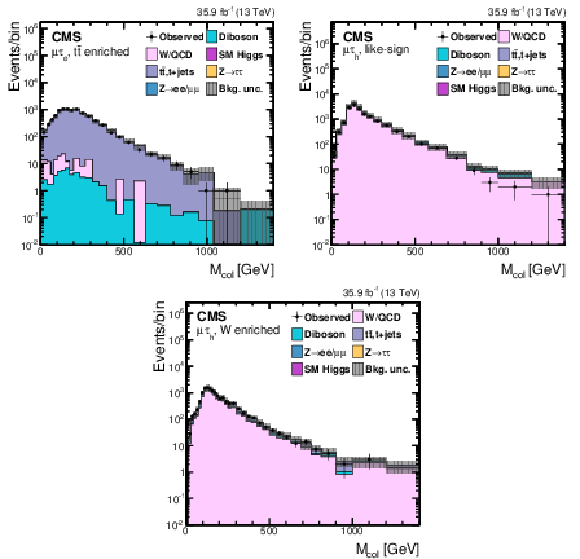
png pdf |
Figure 1:
The ${M_{\text {col}}}$ distribution in the ${\mathrm{t} {}\mathrm{\bar{t}}} $ enriched (upper left), like-sign lepton (upper right), and W+jets enriched (lower) control samples defined in the text. The uncertainty bands include both statistical and systematic uncertainties from Section 7. No fit is performed for these distributions. |
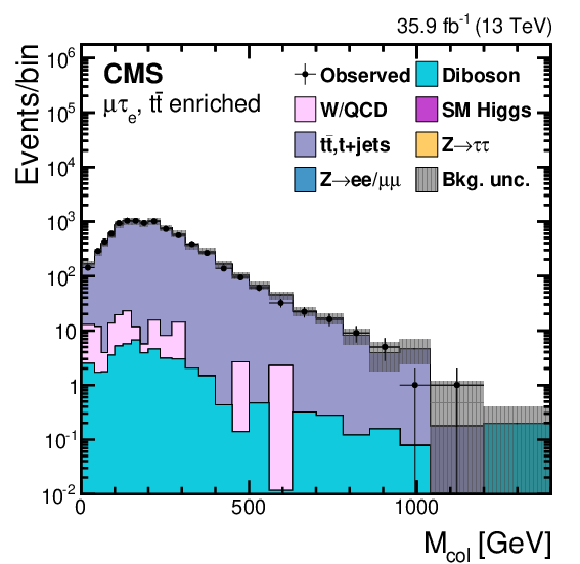
png pdf |
Figure 1-a:
The ${M_{\text {col}}}$ distribution in the ${\mathrm{t} {}\mathrm{\bar{t}}} $ enriched control sample defined in the text. The uncertainty bands include both statistical and systematic uncertainties from Section 7. No fit is performed for these distributions. |
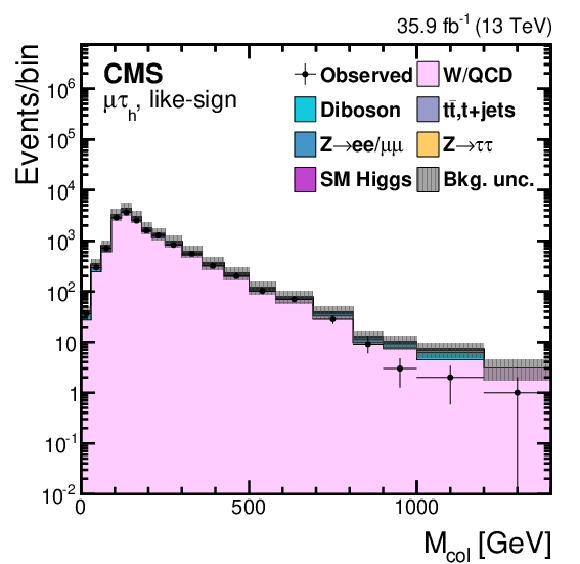
png pdf |
Figure 1-b:
The ${M_{\text {col}}}$ distribution in the like-sign lepton control sample defined in the text. The uncertainty bands include both statistical and systematic uncertainties from Section 7. No fit is performed for these distributions. |
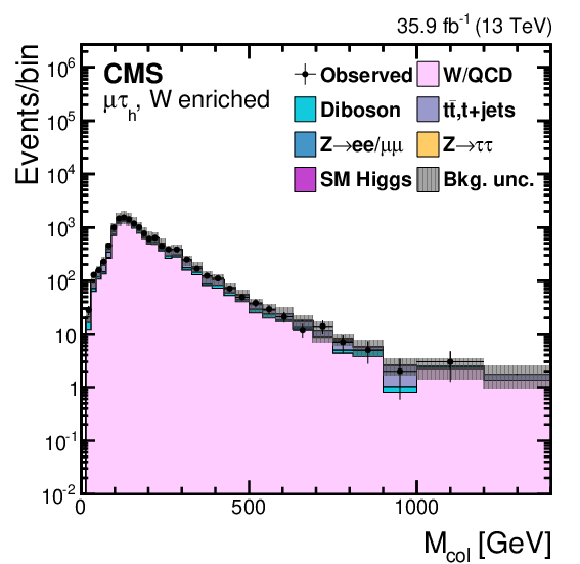
png pdf |
Figure 1-c:
The ${M_{\text {col}}}$ distribution in the W+jets enriched control sample defined in the text. The uncertainty bands include both statistical and systematic uncertainties from Section 7. No fit is performed for these distributions. |
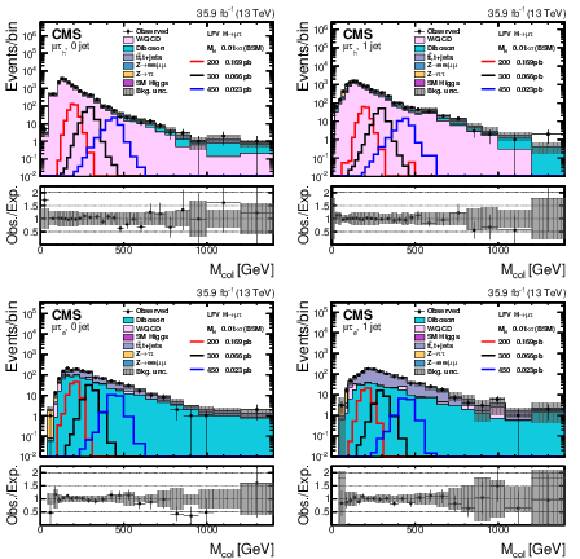
png pdf |
Figure 2:
The ${M_{\text {col}}}$ distribution in the signal region, for the $\mu {\tau _\mathrm {h}} $ (upper) and $\mu \tau _{\mathrm{e}} $ (lower) channels for the Higgs boson mass in the range 200-450 GeV for 0-jet (left) and 1-jet (right) categories. The uncertainty bands include both statistical and systematic uncertainties. The plotted values are number of events per bin using a variable bin size. The background is normalised to the best fit values from a binned likelihood fit, discussed in the text, to the background only hypothesis. For depicting the signals a branching fraction of 1% and BSM cross sections from Ref. [78] are assumed. |
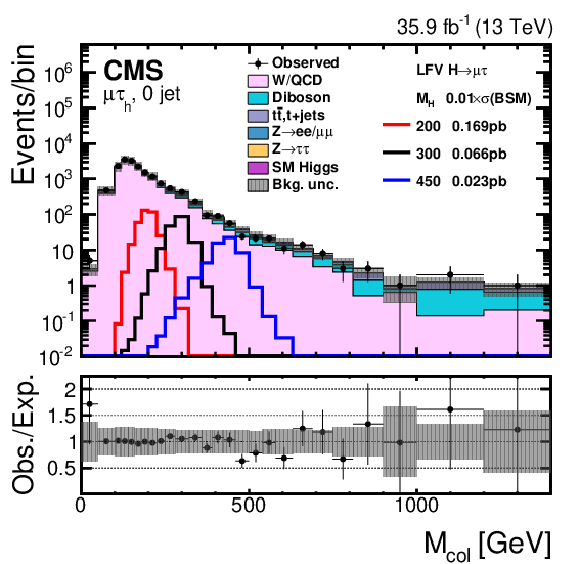
png pdf |
Figure 2-a:
The ${M_{\text {col}}}$ distribution in the signal region, for the $\mu {\tau _\mathrm {h}} $ channel for the Higgs boson mass in the range 200-450 GeV for the 0-jet category. The uncertainty bands include both statistical and systematic uncertainties. The plotted values are number of events per bin using a variable bin size. The background is normalised to the best fit values from a binned likelihood fit, discussed in the text, to the background only hypothesis. For depicting the signals a branching fraction of 1% and BSM cross sections from Ref. [78] are assumed. |
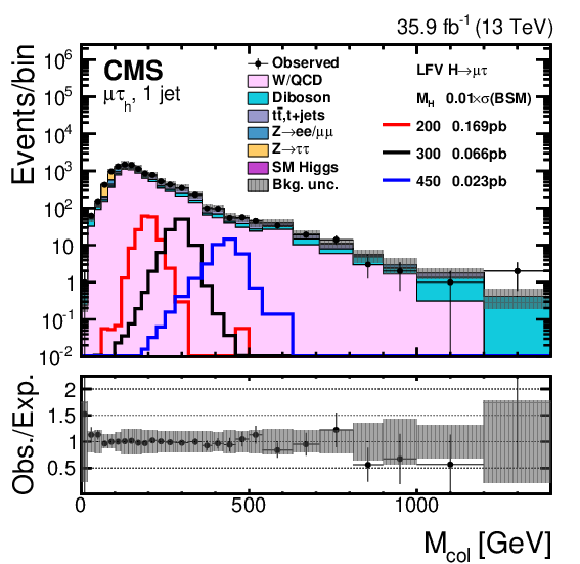
png pdf |
Figure 2-b:
The ${M_{\text {col}}}$ distribution in the signal region, for the $\mu {\tau _\mathrm {h}} $ channel for the Higgs boson mass in the range 200-450 GeV for the 1-jet category. The uncertainty bands include both statistical and systematic uncertainties. The plotted values are number of events per bin using a variable bin size. The background is normalised to the best fit values from a binned likelihood fit, discussed in the text, to the background only hypothesis. For depicting the signals a branching fraction of 1% and BSM cross sections from Ref. [78] are assumed. |
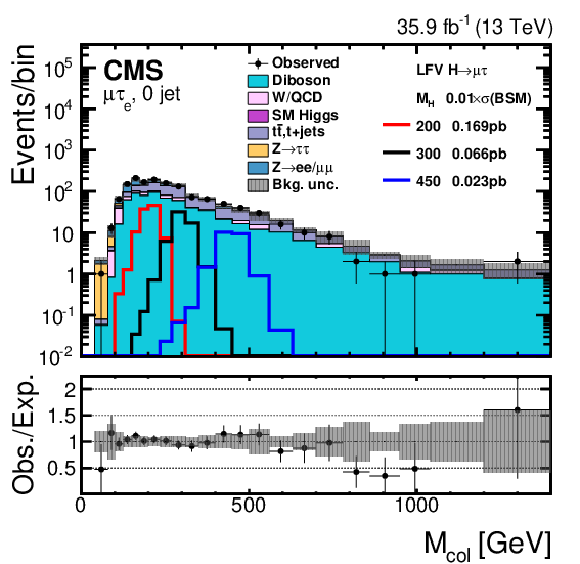
png pdf |
Figure 2-c:
The ${M_{\text {col}}}$ distribution in the signal region, for the $\mu \tau _{\mathrm{e}} $ channel for the Higgs boson mass in the range 200-450 GeV for the 0-jet category. The uncertainty bands include both statistical and systematic uncertainties. The plotted values are number of events per bin using a variable bin size. The background is normalised to the best fit values from a binned likelihood fit, discussed in the text, to the background only hypothesis. For depicting the signals a branching fraction of 1% and BSM cross sections from Ref. [78] are assumed. |

png pdf |
Figure 2-d:
The ${M_{\text {col}}}$ distribution in the signal region, for the $\mu \tau _{\mathrm{e}} $ channel for the Higgs boson mass in the range 200-450 GeV for the 1-jet category. The uncertainty bands include both statistical and systematic uncertainties. The plotted values are number of events per bin using a variable bin size. The background is normalised to the best fit values from a binned likelihood fit, discussed in the text, to the background only hypothesis. For depicting the signals a branching fraction of 1% and BSM cross sections from Ref. [78] are assumed. |
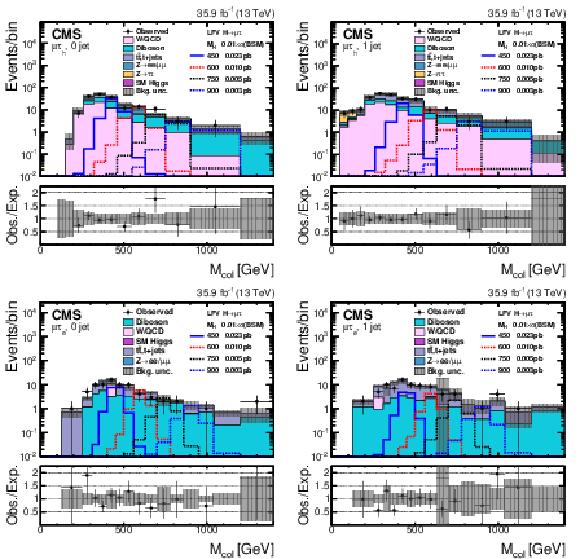
png pdf |
Figure 3:
The ${M_{\text {col}}}$ distribution in the signal region, for the $\mu {\tau _\mathrm {h}} $ (upper) and $\mu \tau _{\mathrm{e}} $ (lower) channels for the Higgs boson mass in the range 450-900 GeV for 0-jet (left) and 1-jet (right) categories. The uncertainty bands include both statistical and systematic uncertainties. The plotted values are number of events per bin using a variable bin size. The background is normalised to the best fit values from a binned likelihood fit, discussed in the text, to the background only hypothesis. For depicting the signals a branching fraction of 1% and BSM cross sections from Ref. [78] are assumed. |
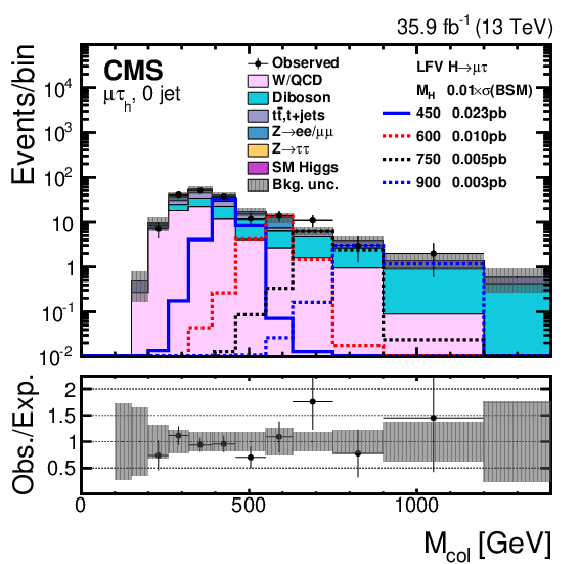
png pdf |
Figure 3-a:
The ${M_{\text {col}}}$ distribution in the signal region, for the $\mu {\tau _\mathrm {h}} $ channel for the Higgs boson mass in the range 450-900 GeV for the 0-jet category. The uncertainty bands include both statistical and systematic uncertainties. The plotted values are number of events per bin using a variable bin size. The background is normalised to the best fit values from a binned likelihood fit, discussed in the text, to the background only hypothesis. For depicting the signals a branching fraction of 1% and BSM cross sections from Ref. [78] are assumed. |
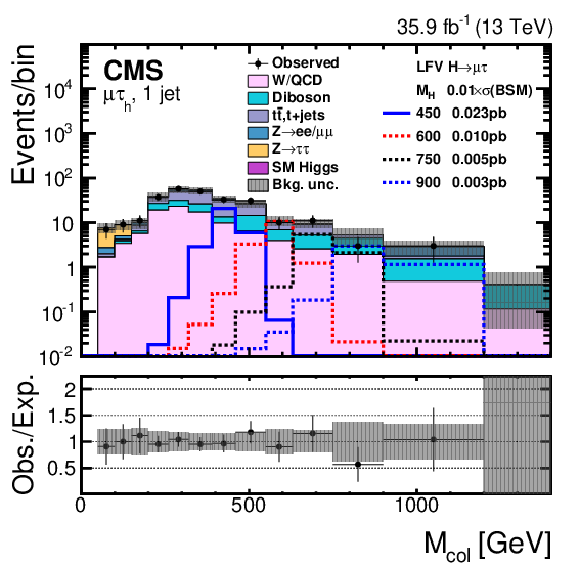
png pdf |
Figure 3-b:
The ${M_{\text {col}}}$ distribution in the signal region, for the $\mu {\tau _\mathrm {h}} $ channel for the Higgs boson mass in the range 450-900 GeV for the 1-jet category. The uncertainty bands include both statistical and systematic uncertainties. The plotted values are number of events per bin using a variable bin size. The background is normalised to the best fit values from a binned likelihood fit, discussed in the text, to the background only hypothesis. For depicting the signals a branching fraction of 1% and BSM cross sections from Ref. [78] are assumed. |

png pdf |
Figure 3-c:
The ${M_{\text {col}}}$ distribution in the signal region, for the $\mu \tau _{\mathrm{e}} $ channel for the Higgs boson mass in the range 450-900 GeV for the 0-jet category. The uncertainty bands include both statistical and systematic uncertainties. The plotted values are number of events per bin using a variable bin size. The background is normalised to the best fit values from a binned likelihood fit, discussed in the text, to the background only hypothesis. For depicting the signals a branching fraction of 1% and BSM cross sections from Ref. [78] are assumed. |
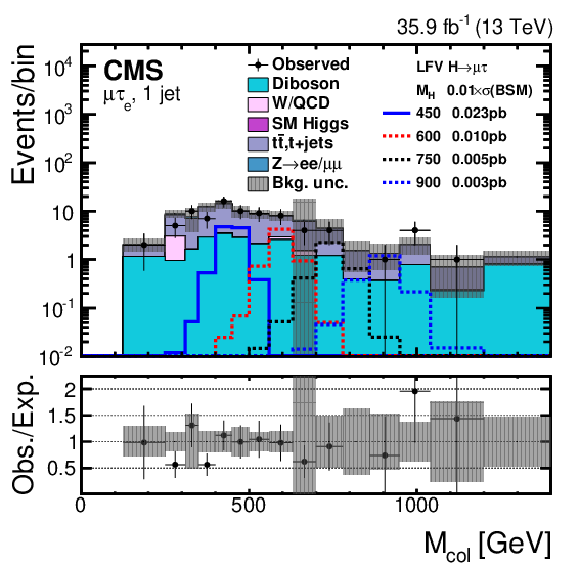
png pdf |
Figure 3-d:
The ${M_{\text {col}}}$ distribution in the signal region, for the $\mu \tau _{\mathrm{e}} $ channel for the Higgs boson mass in the range 450-900 GeV for the 1-jet category. The uncertainty bands include both statistical and systematic uncertainties. The plotted values are number of events per bin using a variable bin size. The background is normalised to the best fit values from a binned likelihood fit, discussed in the text, to the background only hypothesis. For depicting the signals a branching fraction of 1% and BSM cross sections from Ref. [78] are assumed. |
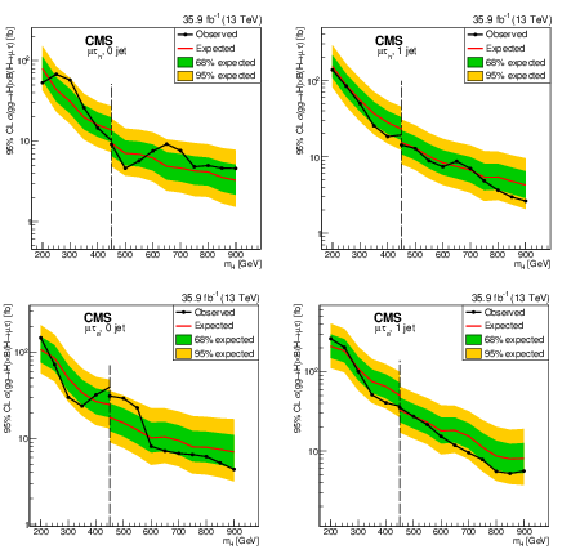
png pdf |
Figure 4:
The observed and median expected 95% CL upper limits on $\sigma (\mathrm{g} \mathrm{g} \to \mathrm{H})\mathcal {B}(\mathrm{H} \to \mu \tau)$, for the $\mu {\tau _\mathrm {h}} $ (upper) and $\mu \tau _{\mathrm{e}} $ (lower) channels, for 0-jet (left) and 1-jet (right) categories. The dashed line shows the transition between the two investigated mass ranges. |

png pdf |
Figure 4-a:
The observed and median expected 95% CL upper limits on $\sigma (\mathrm{g} \mathrm{g} \to \mathrm{H})\mathcal {B}(\mathrm{H} \to \mu \tau)$, for the $\mu {\tau _\mathrm {h}} $ channel, for the 0-jet category. The dashed line shows the transition between the two investigated mass ranges. |
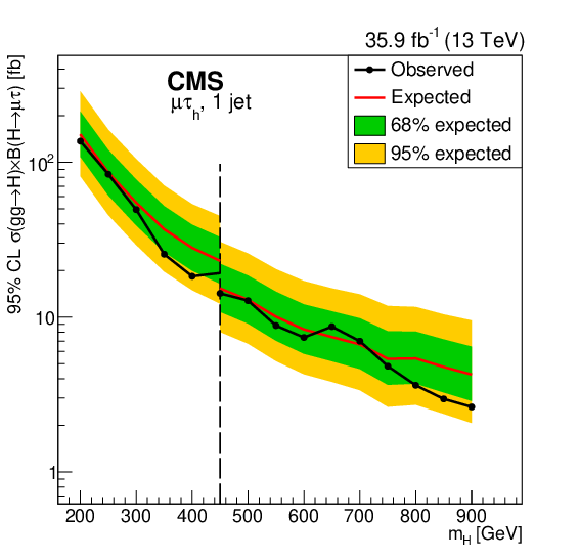
png pdf |
Figure 4-b:
The observed and median expected 95% CL upper limits on $\sigma (\mathrm{g} \mathrm{g} \to \mathrm{H})\mathcal {B}(\mathrm{H} \to \mu \tau)$, for the $\mu {\tau _\mathrm {h}} $ channel, for the 1-jet category. The dashed line shows the transition between the two investigated mass ranges. |
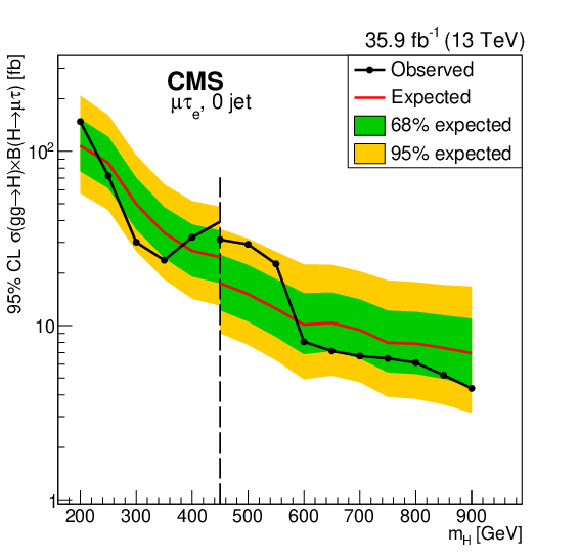
png pdf |
Figure 4-c:
The observed and median expected 95% CL upper limits on $\sigma (\mathrm{g} \mathrm{g} \to \mathrm{H})\mathcal {B}(\mathrm{H} \to \mu \tau)$, for the $\mu \tau _{\mathrm{e}} $ channel, for the 0-jet category. The dashed line shows the transition between the two investigated mass ranges. |
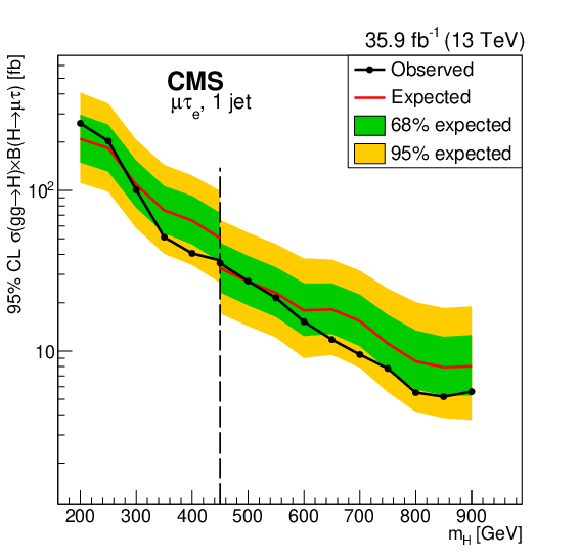
png pdf |
Figure 4-d:
The observed and median expected 95% CL upper limits on $\sigma (\mathrm{g} \mathrm{g} \to \mathrm{H})\mathcal {B}(\mathrm{H} \to \mu \tau)$, for the $\mu \tau _{\mathrm{e}} $ channel, for the 1-jet category. The dashed line shows the transition between the two investigated mass ranges. |
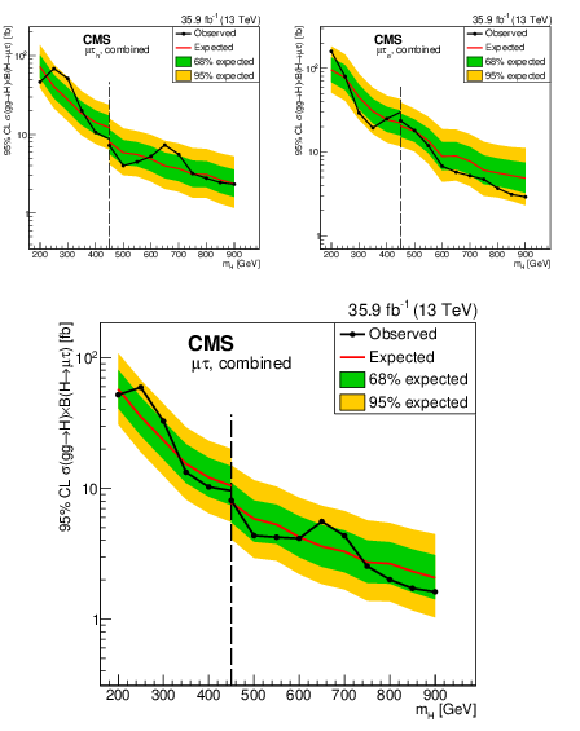
png pdf |
Figure 5:
The combined observed and median expected 95% CL upper limits on $\sigma (\mathrm{g} \mathrm{g} \to \mathrm{H})\mathcal {B}(\mathrm{H} \to \mu \tau)$, for $\mu {\tau _\mathrm {h}} $ (upper left) and $\mu \tau _{\mathrm{e}} $ (lower right) channels, and their combination $\mu \tau $ (lower). The dashed line shows the transition between the two investigated mass ranges. |
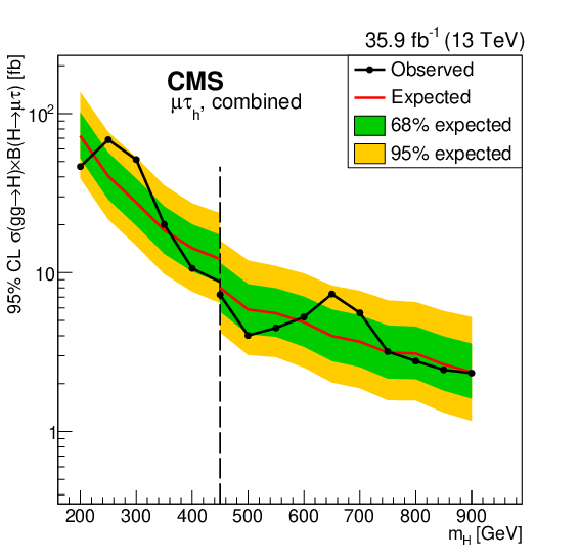
png pdf |
Figure 5-a:
The combined observed and median expected 95% CL upper limits on $\sigma (\mathrm{g} \mathrm{g} \to \mathrm{H})\mathcal {B}(\mathrm{H} \to \mu \tau)$, for the $\mu {\tau _\mathrm {h}} $ channel. The dashed line shows the transition between the two investigated mass ranges. |
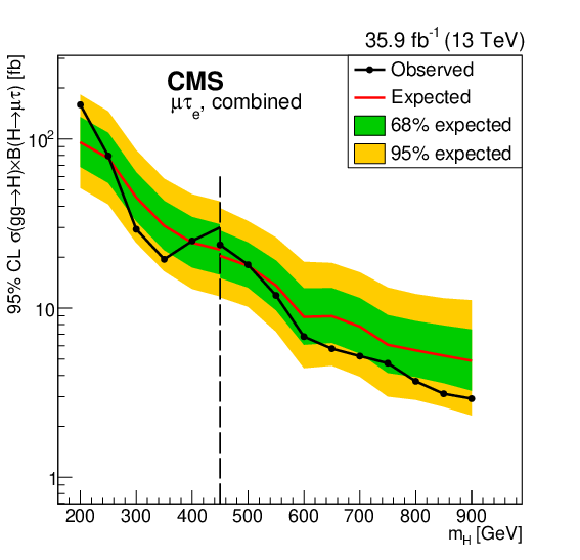
png pdf |
Figure 5-b:
The combined observed and median expected 95% CL upper limits on $\sigma (\mathrm{g} \mathrm{g} \to \mathrm{H})\mathcal {B}(\mathrm{H} \to \mu \tau)$, for the $\mu \tau _{\mathrm{e}} $ channel. The dashed line shows the transition between the two investigated mass ranges. |
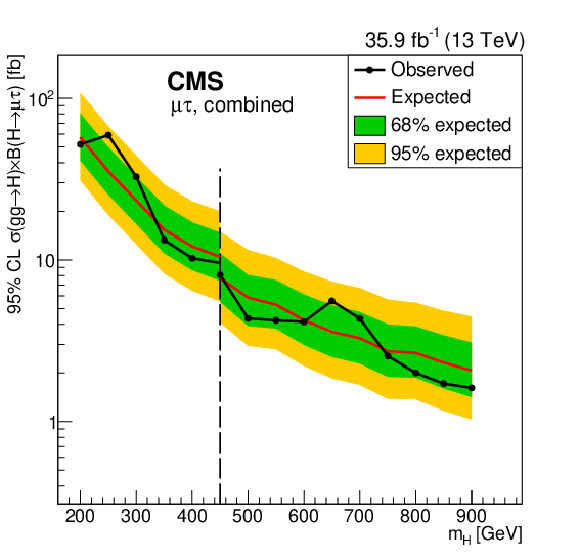
png pdf |
Figure 5-c:
The combined observed and median expected 95% CL upper limits on $\sigma (\mathrm{g} \mathrm{g} \to \mathrm{H})\mathcal {B}(\mathrm{H} \to \mu \tau)$, for the combination $\mu \tau $ of the $\mu {\tau _\mathrm {h}} $ and $\mu \tau _{\mathrm{e}} $ channels. The dashed line shows the transition between the two investigated mass ranges. |

png pdf |
Figure 6:
The ${M_{\text {col}}}$ distribution in the signal region, for the e$ {\tau _\mathrm {h}} $ (upper) and e$ \tau _\mu $ (lower) channels for the Higgs boson mass in the range 200-450 GeV for 0-jet (left) and 1-jet (right) categories. The uncertainty bands include both statistical and systematic uncertainties. The plotted values are number of events per bin using a variable bin size. The background is normalised to the best fit values from a binned likelihood fit, discussed in the text, to the background only hypothesis. For depicting the signals a branching fraction of 1% and BSM cross sections from Ref. [78] are assumed. |

png pdf |
Figure 6-a:
The ${M_{\text {col}}}$ distribution in the signal region, for the e$ {\tau _\mathrm {h}} $ channel for the Higgs boson mass in the range 200-450 GeV for the 0-jet category. The uncertainty bands include both statistical and systematic uncertainties. The plotted values are number of events per bin using a variable bin size. The background is normalised to the best fit values from a binned likelihood fit, discussed in the text, to the background only hypothesis. For depicting the signals a branching fraction of 1% and BSM cross sections from Ref. [78] are assumed. |
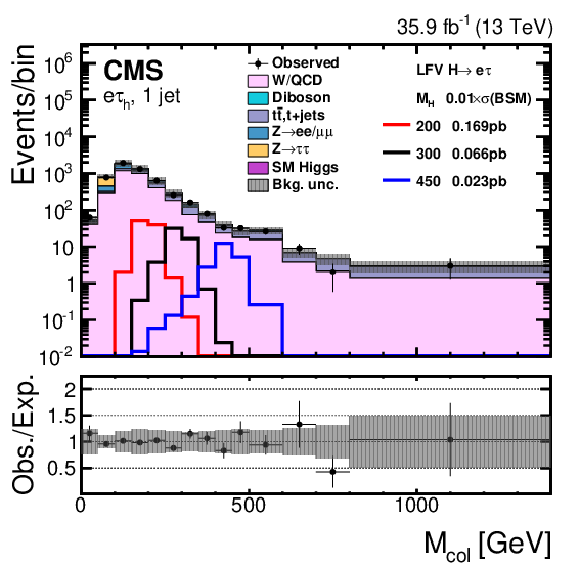
png pdf |
Figure 6-b:
The ${M_{\text {col}}}$ distribution in the signal region, for the e$ {\tau _\mathrm {h}} $ channel for the Higgs boson mass in the range 200-450 GeV for the 1-jet category. The uncertainty bands include both statistical and systematic uncertainties. The plotted values are number of events per bin using a variable bin size. The background is normalised to the best fit values from a binned likelihood fit, discussed in the text, to the background only hypothesis. For depicting the signals a branching fraction of 1% and BSM cross sections from Ref. [78] are assumed. |
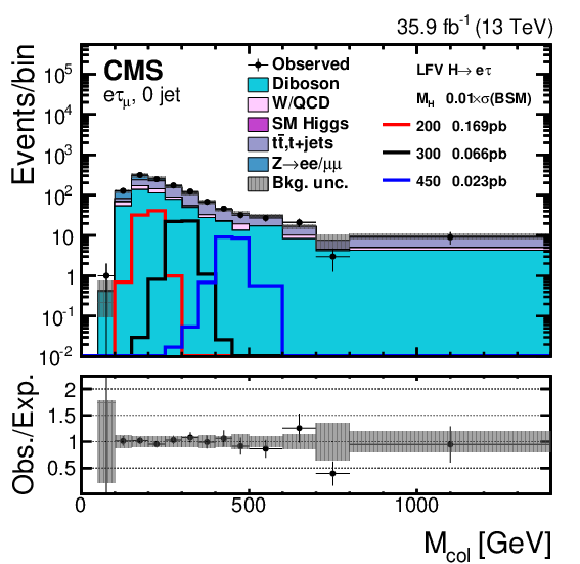
png pdf |
Figure 6-c:
The ${M_{\text {col}}}$ distribution in the signal region, for the e$ \tau _\mu $ channel for the Higgs boson mass in the range 200-450 GeV for the 0-jet category. The uncertainty bands include both statistical and systematic uncertainties. The plotted values are number of events per bin using a variable bin size. The background is normalised to the best fit values from a binned likelihood fit, discussed in the text, to the background only hypothesis. For depicting the signals a branching fraction of 1% and BSM cross sections from Ref. [78] are assumed. |
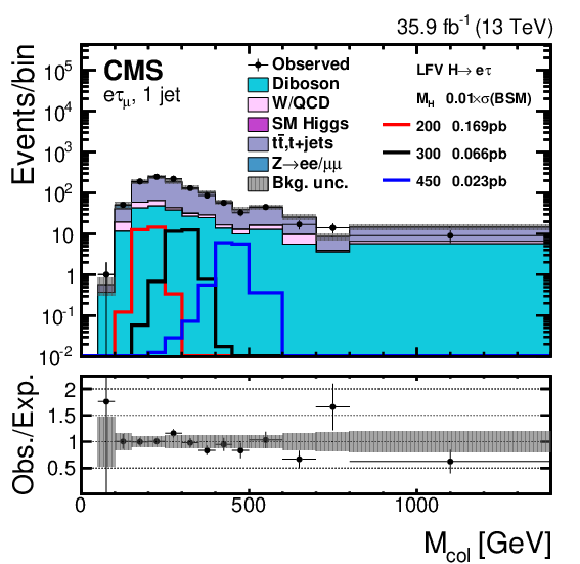
png pdf |
Figure 6-d:
The ${M_{\text {col}}}$ distribution in the signal region, for the e$ \tau _\mu $ channel for the Higgs boson mass in the range 200-450 GeV for the 1-jet category. The uncertainty bands include both statistical and systematic uncertainties. The plotted values are number of events per bin using a variable bin size. The background is normalised to the best fit values from a binned likelihood fit, discussed in the text, to the background only hypothesis. For depicting the signals a branching fraction of 1% and BSM cross sections from Ref. [78] are assumed. |
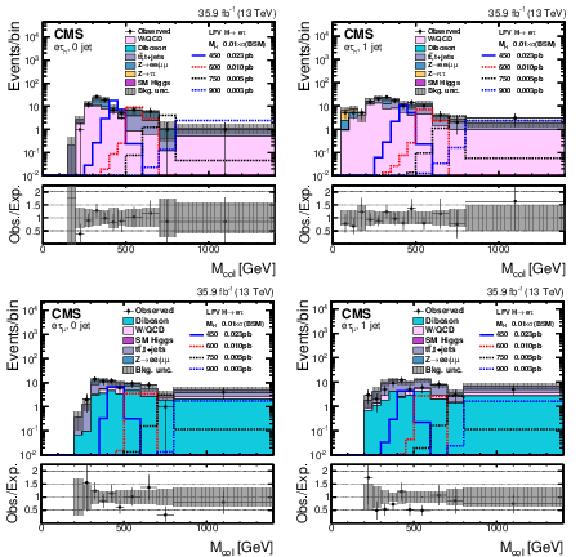
png pdf |
Figure 7:
The ${M_{\text {col}}}$ distribution in the signal region, for the e$ {\tau _\mathrm {h}} $ (upper) and e$ \tau _\mu $ (lower) channels for the Higgs boson mass in the range 450-900 GeV for 0-jet (left) and 1-jet (right) categories. The uncertainty bands include both statistical and systematic uncertainties. The plotted values are number of events per bin using a variable bin size. The background is normalised to the best fit values from a binned likelihood fit, discussed in the text, to the background only hypothesis. For depicting the signals a branching fraction of 1% and BSM cross sections from Ref. [78] are assumed. |
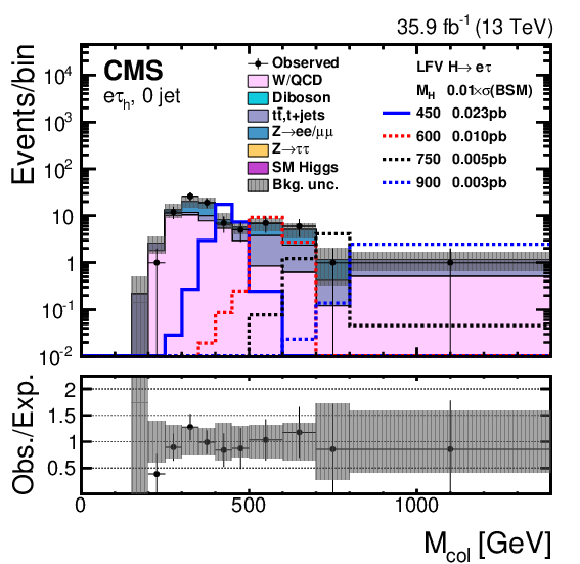
png pdf |
Figure 7-a:
The ${M_{\text {col}}}$ distribution in the signal region, for the e$ {\tau _\mathrm {h}} $ channel for the Higgs boson mass in the range 450-900 GeV for the 0-jet category. The uncertainty bands include both statistical and systematic uncertainties. The plotted values are number of events per bin using a variable bin size. The background is normalised to the best fit values from a binned likelihood fit, discussed in the text, to the background only hypothesis. For depicting the signals a branching fraction of 1% and BSM cross sections from Ref. [78] are assumed. |

png pdf |
Figure 7-b:
The ${M_{\text {col}}}$ distribution in the signal region, for the e$ {\tau _\mathrm {h}} $ channel for the Higgs boson mass in the range 450-900 GeV for the 1-jet category. The uncertainty bands include both statistical and systematic uncertainties. The plotted values are number of events per bin using a variable bin size. The background is normalised to the best fit values from a binned likelihood fit, discussed in the text, to the background only hypothesis. For depicting the signals a branching fraction of 1% and BSM cross sections from Ref. [78] are assumed. |
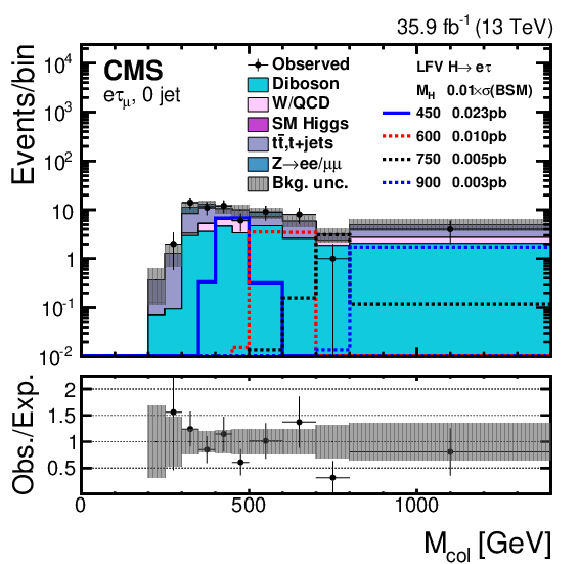
png pdf |
Figure 7-c:
The ${M_{\text {col}}}$ distribution in the signal region, for the e$ \tau _\mu $ channel for the Higgs boson mass in the range 450-900 GeV for the 0-jet category. The uncertainty bands include both statistical and systematic uncertainties. The plotted values are number of events per bin using a variable bin size. The background is normalised to the best fit values from a binned likelihood fit, discussed in the text, to the background only hypothesis. For depicting the signals a branching fraction of 1% and BSM cross sections from Ref. [78] are assumed. |

png pdf |
Figure 7-d:
The ${M_{\text {col}}}$ distribution in the signal region, for the e$ \tau _\mu $ channel for the Higgs boson mass in the range 450-900 GeV for the 1-jet category. The uncertainty bands include both statistical and systematic uncertainties. The plotted values are number of events per bin using a variable bin size. The background is normalised to the best fit values from a binned likelihood fit, discussed in the text, to the background only hypothesis. For depicting the signals a branching fraction of 1% and BSM cross sections from Ref. [78] are assumed. |

png pdf |
Figure 8:
The observed and median expected 95% CL upper limits on $\sigma (\mathrm{g} \mathrm{g} \to \mathrm{H})\mathcal {B}(\mathrm{H} \to {\mathrm{e}} \tau)$, for the e$ {\tau _\mathrm {h}} $ (upper) and e$ \tau _\mu $ (lower) channels, for 0-jet (left) and 1-jet (right) categories. The dashed line shows the transition between the two investigated mass ranges. |
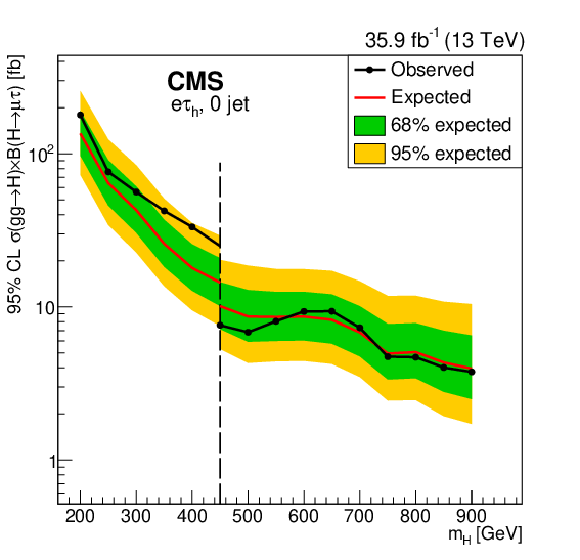
png pdf |
Figure 8-a:
The observed and median expected 95% CL upper limits on $\sigma (\mathrm{g} \mathrm{g} \to \mathrm{H})\mathcal {B}(\mathrm{H} \to {\mathrm{e}} \tau)$, for the e$ {\tau _\mathrm {h}} $ channel, for the 0-jet category. The dashed line shows the transition between the two investigated mass ranges. |
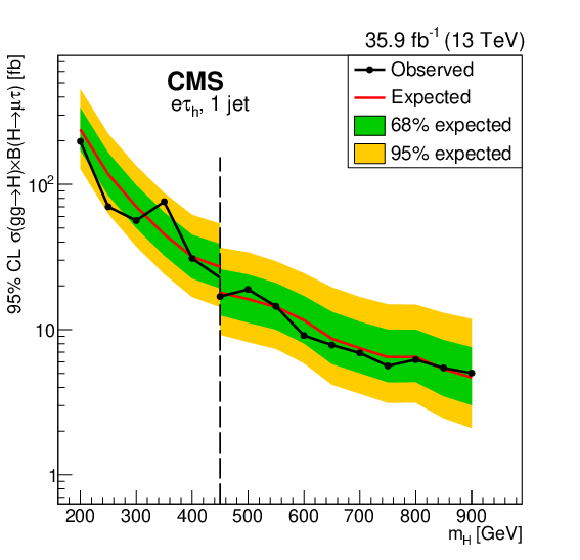
png pdf |
Figure 8-b:
The observed and median expected 95% CL upper limits on $\sigma (\mathrm{g} \mathrm{g} \to \mathrm{H})\mathcal {B}(\mathrm{H} \to {\mathrm{e}} \tau)$, for the e$ {\tau _\mathrm {h}} $ channel, for the 1-jet category. The dashed line shows the transition between the two investigated mass ranges. |
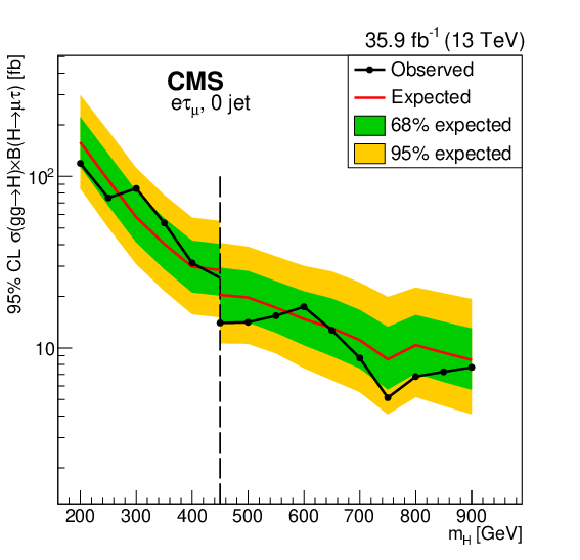
png pdf |
Figure 8-c:
The observed and median expected 95% CL upper limits on $\sigma (\mathrm{g} \mathrm{g} \to \mathrm{H})\mathcal {B}(\mathrm{H} \to {\mathrm{e}} \tau)$, for the e$ \tau _\mu $ channel, for the 0-jet category. The dashed line shows the transition between the two investigated mass ranges. |
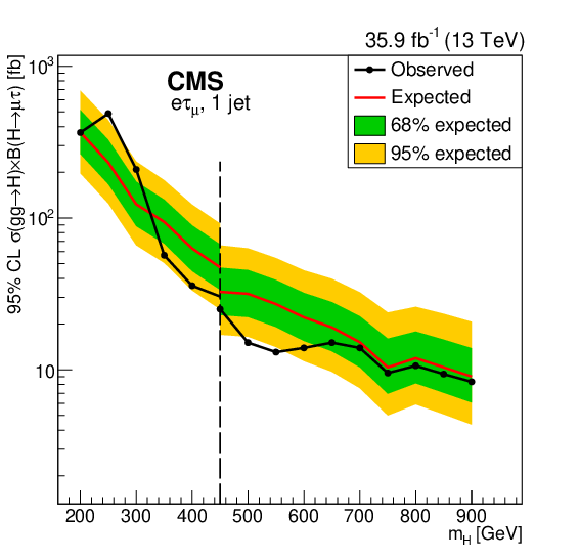
png pdf |
Figure 8-d:
The observed and median expected 95% CL upper limits on $\sigma (\mathrm{g} \mathrm{g} \to \mathrm{H})\mathcal {B}(\mathrm{H} \to {\mathrm{e}} \tau)$, for the e$ \tau _\mu $ channel, for the 1-jet category. The dashed line shows the transition between the two investigated mass ranges. |
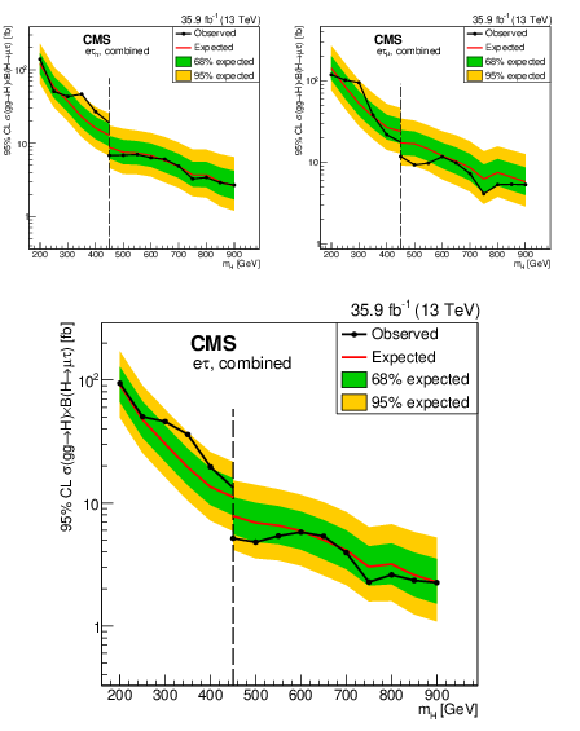
png pdf |
Figure 9:
The combined observed and median expected 95% CL upper limits on $\sigma (\mathrm{g} \mathrm{g} \to \mathrm{H})\mathcal {B}(\mathrm{H} \to {\mathrm{e}} \tau)$, for e$ {\tau _\mathrm {h}} $ (upper left) and e$ \tau _\mu $ (upper right) channels, and their combination e$ \tau $ (lower). The dashed line shows the transition between the two investigated mass ranges. |
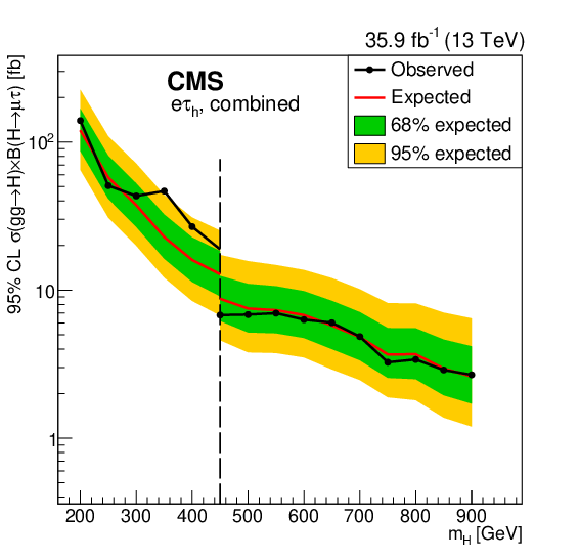
png pdf |
Figure 9-a:
The combined observed and median expected 95% CL upper limits on $\sigma (\mathrm{g} \mathrm{g} \to \mathrm{H})\mathcal {B}(\mathrm{H} \to {\mathrm{e}} \tau)$, for the e$ {\tau _\mathrm {h}} $ channel. The dashed line shows the transition between the two investigated mass ranges. |
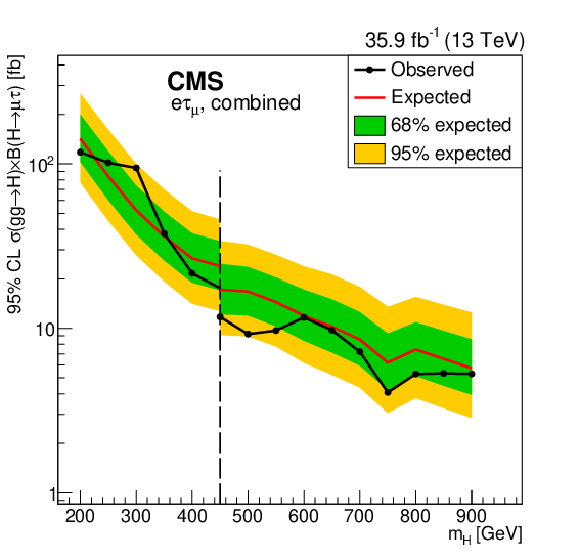
png pdf |
Figure 9-b:
The combined observed and median expected 95% CL upper limits on $\sigma (\mathrm{g} \mathrm{g} \to \mathrm{H})\mathcal {B}(\mathrm{H} \to {\mathrm{e}} \tau)$, for the e$ \tau _\mu $ channel. The dashed line shows the transition between the two investigated mass ranges. |
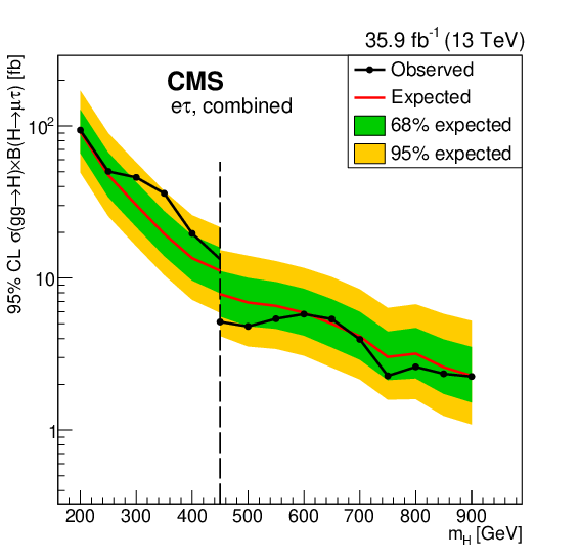
png pdf |
Figure 9-c:
The combined observed and median expected 95% CL upper limits on $\sigma (\mathrm{g} \mathrm{g} \to \mathrm{H})\mathcal {B}(\mathrm{H} \to {\mathrm{e}} \tau)$, for the combination e$ \tau $ of the e$ {\tau _\mathrm {h}} $ and e$ \tau _\mu $ channels. The dashed line shows the transition between the two investigated mass ranges. |
| Tables | |
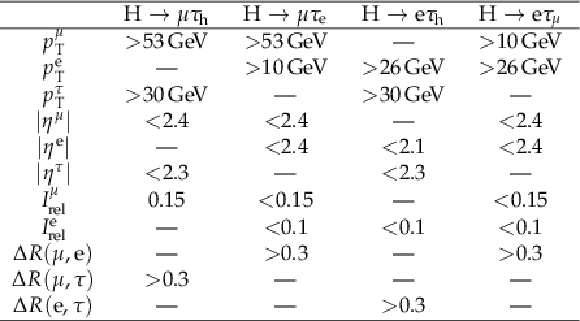
png pdf |
Table 1:
Initial selection criteria applied to the kinematic variables for the ${\mathrm{H} \to \mu \tau} $ and ${\mathrm{H} \to {\mathrm{e}} \tau} $ analyses. The selected sample is used in the background estimation from control samples in data. |
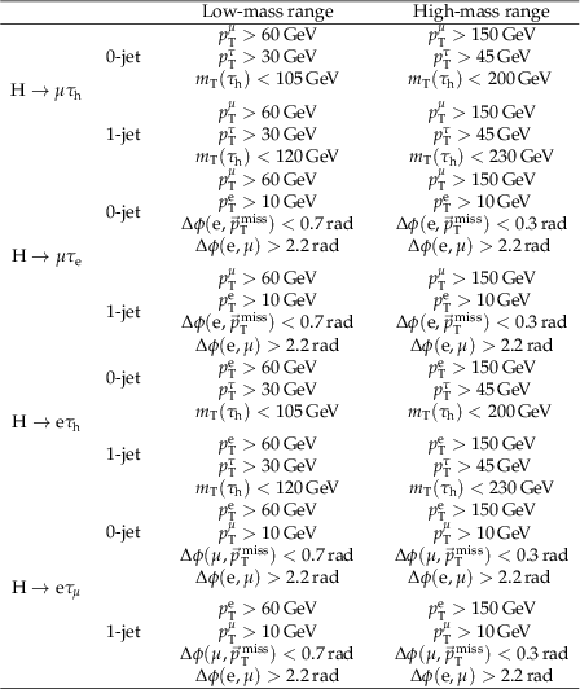
png pdf |
Table 2:
Final event selection criteria for the low-mass range, 200 $ < m_{\mathrm{H}} < $ 450 GeV, and the high-mass range, 450 $ < m_{\mathrm{H}} < $ 900 GeV, considered in the ${\mathrm{H} \to \mu \tau} $ and ${\mathrm{H} \to {\mathrm{e}} \tau} $ analyses. |

png pdf |
Table 3:
The systematic uncertainties for the four channels. All uncertainties are treated as correlated between the categories, except those with more values separated by the $\oplus $ symbol. In the case of two values, the first value is the correlated uncertainty and the second value is the uncorrelated uncertainty for each individual category. In the case of three values, the first and second values correspond to the uncertainties arising from factorisation and renormalisation scales and PDF variations and are correlated between categories, while the third value is the uncorrelated uncertainty for each individual category. Two values separated by the "-" sign represent the range of the uncertainties from the different sources and/or in the different jet categories. |

png pdf |
Table 4:
Theoretical uncertainties from [78] are applied to the Higgs boson production cross sections for the different masses. In the reference, the PDF and $ {\alpha _S} $ uncertainties are computed following the recommendation of the PDF4LHC working group. The remaining Gaussian uncertainty accounts for additional intrinsic sources of theory uncertainty described in detail in the reference. |
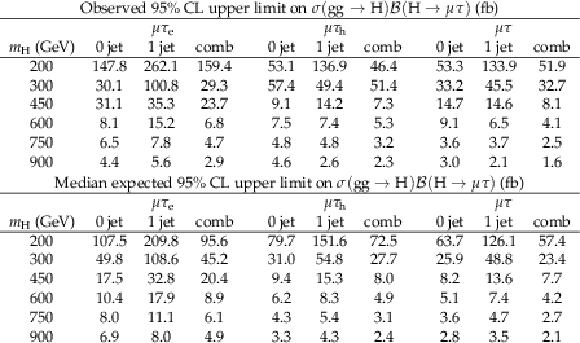
png pdf |
Table 5:
The observed and median expected 95% CL upper limits on $\sigma (\mathrm{g} \mathrm{g} \to \mathrm{H}) \mathcal {B}(\mathrm{H} \to \mu \tau)$. |

png pdf |
Table 6:
The observed and median expected 95% CL upper limits on $\sigma (\mathrm{g} \mathrm{g} \to \mathrm{H})\mathcal {B}(\mathrm{H} \to {\mathrm{e}} \tau)$. |
| Summary |
| The first direct search for lepton flavour violating decays of a neutral non-standard-model Higgs boson (H) in the $\mu\tau$ and e$\tau$ channels is presented in this paper. The analyzed data set corresponds to an integrated luminosity of 35.9 fb$^{-1}$ of proton-proton collision data recorded at $\sqrt{s}=$ 13 TeV. The results are extracted from a fit to the collinear mass distributions. No evidence is found for lepton flavour violating decays of $\mathrm{H}$ in the investigated mass range. The observed (expected) upper limits at 95% confidence level on the product of production cross section with branching fraction, for $\mathrm{H}$ mass in the range 200-900 GeV, decaying to $\mu\tau$ and e$\tau$ vary from 51.9 (57.4) fb to 1.6 (2.1) fb and from 94.1 (91.6) fb to 2.3 (2.3) fb, respectively. |
| References | ||||
| 1 | ATLAS Collaboration | Observation of a new particle in the search for the standard model Higgs boson with the ATLAS detector at the LHC | PLB 716 (2012) 1 | 1207.7214 |
| 2 | CMS Collaboration | Observation of a new boson at a mass of 125 GeV with the CMS experiment at the LHC | PLB 716 (2012) 30 | CMS-HIG-12-028 1207.7235 |
| 3 | CMS Collaboration | Observation of a new boson with mass near 125 GeV in pp collisions at $ \sqrt{s} = $ 7 and 8 TeV | JHEP 06 (2013) 081 | CMS-HIG-12-036 1303.4571 |
| 4 | F. Englert and R. Brout | Broken symmetry and the mass of gauge vector mesons | PRL 13 (1964) 321 | |
| 5 | P. W. Higgs | Broken symmetries, massless particles and gauge fields | PL12 (1964) 132 | |
| 6 | P. W. Higgs | Broken symmetries and the masses of gauge bosons | PRL 13 (1964) 508 | |
| 7 | G. S. Guralnik, C. R. Hagen, and T. W. B. Kibble | Global conservation laws and massless particles | PRL 13 (1964) 585 | |
| 8 | P. W. Higgs | Spontaneous symmetry breakdown without massless bosons | PR145 (1966) 1156 | |
| 9 | T. W. B. Kibble | Symmetry breaking in non-abelian gauge theories | PR155 (1967) 1554 | |
| 10 | ATLAS and CMS Collaborations | Measurements of the Higgs boson production and decay rates and constraints on its couplings from a combined ATLAS and CMS analysis of the LHC pp collision data at $ \sqrt{s}= $ 7 and 8 TeV | JHEP 08 (2016) 045 | 1606.02266 |
| 11 | CMS Collaboration | Combined measurements of Higgs boson couplings in proton-proton collisions at $ \sqrt{s} = $ 13 TeV | EPJC 79 (2019) 421 | CMS-HIG-17-031 1809.10733 |
| 12 | M. Buschmann, J. Kopp, J. Liu, and X.-P. Wang | New signatures of flavor violating Higgs couplings | JHEP 06 (2016) 149 | 1601.02616 |
| 13 | J. D. Bjorken and S. Weinberg | Mechanism for nonconservation of muon number | PRL 38 (1977) 622 | |
| 14 | J. L. Diaz-Cruz and J. J. Toscano | Lepton flavor violating decays of Higgs bosons beyond the standard model | PRD 62 (2000) 116005 | hep-ph/9910233 |
| 15 | T. Han and D. Marfatia | $ h \to \mu \tau $ at hadron colliders | PRL 86 (2001) 1442 | hep-ph/0008141 |
| 16 | E. Arganda, A. M. Curiel, M. J. Herrero, and D. Temes | Lepton flavor violating Higgs boson decays from massive seesaw neutrinos | PRD 71 (2005) 035011 | hep-ph/0407302 |
| 17 | A. Arhrib, Y. Cheng, and O. C. W. Kong | Comprehensive analysis on lepton flavor violating Higgs boson to $ \mu^\mp\tau^\pm $ decay in supersymmetry without R parity | PRD 87 (2013) 015025 | 1210.8241 |
| 18 | M. Arana-Catania, E. Arganda, and M. J. Herrero | Non-decoupling SUSY in LFV Higgs decays: a window to new physics at the LHC | JHEP 09 (2013) 160 | 1304.3371 |
| 19 | E. Arganda, M. J. Herrero, R. Morales, and A. Szynkman | Analysis of the $ h, H, A \to\tau\mu $ decays induced from SUSY loops within the mass insertion approximation | JHEP 03 (2016) 055 | 1510.04685 |
| 20 | E. Arganda, M. J. Herrero, X. Marcano, and C. Weiland | Enhancement of the lepton flavor violating Higgs boson decay rates from SUSY loops in the inverse seesaw model | PRD 93 (2016) 055010 | 1508.04623 |
| 21 | K. Agashe and R. Contino | Composite Higgs-mediated flavor-changing neutral current | PRD 80 (2009) 075016 | 0906.1542 |
| 22 | A. Azatov, M. Toharia, and L. Zhu | Higgs mediated flavor changing neutral currents in warped extra dimensions | PRD 80 (2009) 035016 | 0906.1990 |
| 23 | H. Ishimori et al. | Non-Abelian discrete symmetries in particle physics | Prog. Theor. Phys. Suppl. 183 (2010) 1 | 1003.3552 |
| 24 | G. Perez and L. Randall | Natural neutrino masses and mixings from warped geometry | JHEP 01 (2009) 077 | 0805.4652 |
| 25 | S. Casagrande et al. | Flavor physics in the Randall-Sundrum model I. theoretical setup and electroweak precision tests | JHEP 10 (2008) 094 | 0807.4937 |
| 26 | A. J. Buras, B. Duling, and S. Gori | The impact of Kaluza-Klein fermions on Standard Model fermion couplings in a RS model with custodial protection | JHEP 09 (2009) 076 | 0905.2318 |
| 27 | M. Blanke et al. | $ \Delta F= $ 2 observables and fine-tuning in a warped extra dimension with custodial protection | JHEP 03 (2009) 001 | 0809.1073 |
| 28 | G. F. Giudice and O. Lebedev | Higgs-dependent Yukawa couplings | PLB 665 (2008) 79 | 0804.1753 |
| 29 | J. A. Aguilar-Saavedra | A minimal set of top-Higgs anomalous couplings | NPB 821 (2009) 215 | 0904.2387 |
| 30 | M. E. Albrecht et al. | Electroweak and flavour structure of a warped extra dimension with custodial protection | JHEP 09 (2009) 064 | 0903.2415 |
| 31 | A. Goudelis, O. Lebedev, and J. H. Park | Higgs-induced lepton flavor violation | PLB 707 (2012) 369 | 1111.1715 |
| 32 | D. McKeen, M. Pospelov, and A. Ritz | Modified Higgs branching ratios versus CP and lepton flavor violation | PRD 86 (2012) 113004 | 1208.4597 |
| 33 | A. Pilaftsis | Lepton flavour nonconservation in $ \mathrm{H}^0 $ decays | PLB 285 (1992) 68 | |
| 34 | J. G. Korner, A. Pilaftsis, and K. Schilcher | Leptonic $ \mathrm{CP} $ asymmetries in flavor-changing $ \mathrm{H}^{0} $ decays | PRD 47 (1993) 1080 | |
| 35 | E. Arganda, M. J. Herrero, X. Marcano, and C. Weiland | Imprints of massive inverse seesaw model neutrinos in lepton flavor violating Higgs boson decays | PRD 91 (2015) 015001 | 1405.4300 |
| 36 | M. Sher and K. Thrasher | Flavor-changing leptonic decays of heavy Higgs bosons | PRD 93 (2016) 055021 | 1601.03973 |
| 37 | CMS Collaboration | Search for lepton flavour violating decays of the Higgs boson to $ \mu\tau $ and $ \mathrm{e}\tau $ in proton-proton collisions at $ \sqrt{s}= $ 13 TeV | JHEP 06 (2018) 001 | CMS-HIG-17-001 1712.07173 |
| 38 | CMS Collaboration | Search for lepton-flavour-violating decays of the Higgs boson | PLB 749 (2015) 337 | CMS-HIG-14-005 1502.07400 |
| 39 | CMS Collaboration | Search for lepton flavour violating decays of the Higgs boson to e$ \tau $ and e$ \mu $ in proton-proton collisions at $ \sqrt{s} = $ 8 TeV | PLB 763 (2016) 472 | CMS-HIG-14-040 1607.03561 |
| 40 | ATLAS Collaboration | Search for lepton-flavour-violating decays of the Higgs and $ Z $ bosons with the ATLAS detector | EPJC 77 (2017) 70 | 1604.07730 |
| 41 | ATLAS Collaboration | Search for lepton-flavour-violating $ \mathrm{H}\to\mu\tau $ decays of the Higgs boson with the ATLAS detector | JHEP 11 (2015) 211 | 1508.03372 |
| 42 | CMS Collaboration | Evidence for the direct decay of the 125 GeV Higgs boson to fermions | NP 10 (2014) 557 | CMS-HIG-13-033 1401.6527 |
| 43 | CMS Collaboration | Evidence for the 125 GeV Higgs boson decaying to a pair of $ \tau $ leptons | JHEP 05 (2014) 104 | CMS-HIG-13-004 1401.5041 |
| 44 | CMS Collaboration | Observation of the Higgs boson decay to a pair of $ \tau $ leptons with the CMS detector | PLB 779 (2018) 283 | CMS-HIG-16-043 1708.00373 |
| 45 | CMS Collaboration | Search for additional neutral MSSM Higgs bosons in the $ \tau\tau $ final state in proton-proton collisions at $ \sqrt{s} = $ 13 TeV | JHEP 07 (2018) 007 | CMS-HIG-13-021 1408.3316 |
| 46 | ATLAS Collaboration | Evidence for the Higgs-boson Yukawa coupling to tau leptons with the ATLAS detector | JHEP 04 (2015) 117 | 1501.04943 |
| 47 | CMS Collaboration | The CMS experiment at the CERN LHC | JINST 3 (2008) S08004 | CMS-00-001 |
| 48 | CMS Collaboration | The CMS trigger system | JINST 12 (2017) P01020 | CMS-TRG-12-001 1609.02366 |
| 49 | CMS Collaboration | CMS luminosity measurements for the 2016 data taking period | CMS-PAS-LUM-17-001 | CMS-PAS-LUM-17-001 |
| 50 | P. Nason | A new method for combining NLO QCD with shower Monte Carlo algorithms | JHEP 11 (2004) 040 | hep-ph/0409146 |
| 51 | S. Frixione, P. Nason, and C. Oleari | Matching NLO QCD computations with parton shower simulations: the POWHEG method | JHEP 11 (2007) 070 | 0709.2092 |
| 52 | S. Alioli, P. Nason, C. Oleari, and E. Re | A general framework for implementing NLO calculations in shower Monte Carlo programs: the POWHEG BOX | JHEP 06 (2010) 043 | 1002.2581 |
| 53 | S. Alioli et al. | Jet pair production in POWHEG | JHEP 04 (2011) 081 | 1012.3380 |
| 54 | S. Alioli, P. Nason, C. Oleari, and E. Re | NLO Higgs boson production via gluon fusion matched with shower in POWHEG | JHEP 04 (2009) 002 | 0812.0578 |
| 55 | E. Bagnaschi, G. Degrassi, P. Slavich, and A. Vicini | Higgs production via gluon fusion in the POWHEG approach in the SM and in the MSSM | JHEP 02 (2012) 088 | 1111.2854 |
| 56 | H. M. Georgi, S. L. Glashow, M. E. Machacek, and D. V. Nanopoulos | Higgs bosons from two-gluon annihilation in proton proton collisions | PRL 40 (1978) 692 | |
| 57 | J. Alwall et al. | The automated computation of tree-level and next-to-leading order differential cross sections, and their matching to parton shower simulations | JHEP 07 (2014) 079 | 1405.0301 |
| 58 | J. Alwall et al. | Comparative study of various algorithms for the merging of parton showers and matrix elements in hadronic collisions | EPJC 53 (2008) 473 | 0706.2569 |
| 59 | R. Frederix and S. Frixione | Merging meets matching in MC@NLO | JHEP 12 (2012) 061 | 1209.6215 |
| 60 | T. Sjostrand et al. | An introduction to PYTHIA 8.2 | CPC 191 (2015) 159 | 1410.3012 |
| 61 | CMS Collaboration | Event generator tunes obtained from underlying event and multiparton scattering measurements | EPJC 76 (2016) 155 | CMS-GEN-14-001 1512.00815 |
| 62 | R. D. Ball et al. | Unbiased global determination of parton distributions and their uncertainties at NNLO and at LO | Nuclear Physics B 855 (2012) 153 | 1107.2652 |
| 63 | GEANT4 Collaboration | GEANT4--a simulation toolkit | NIMA 506 (2003) 250 | |
| 64 | CMS Collaboration | Particle-flow reconstruction and global event description with the CMS detector | JINST 12 (2017) P10003 | CMS-PRF-14-001 1706.04965 |
| 65 | M. Cacciari, G. P. Salam, and G. Soyez | The anti-$ {k_{\mathrm{T}}} $ jet clustering algorithm | JHEP 04 (2008) 063 | 0802.1189 |
| 66 | M. Cacciari, G. P. Salam, and G. Soyez | FastJet user manual | EPJC 72 (2012) 1896 | 1111.6097 |
| 67 | CMS Collaboration | Performance of the CMS muon detector and muon reconstruction with proton-proton collisions at $ \sqrt{s}= $ 13 TeV | JINST 13 (2018) P06015 | 1804.04528v2 |
| 68 | CMS Collaboration | Performance of electron reconstruction and selection with the CMS detector in proton-proton collisions at $ \sqrt{s} = $ 8 TeV | JINST 10 (2015) P06005 | CMS-EGM-13-001 1502.02701 |
| 69 | M. Cacciari, G. P. Salam | Dispelling the $ N^{3} $ myth for the $ {k_{\mathrm{T}}} $ jet-finder | PLB 641 (2006) 57 | hep-ph/0512210 |
| 70 | CMS Collaboration | Jet energy scale and resolution in the CMS experiment in pp collisions at 8 TeV | JINST 12 (2017) P02014 | CMS-JME-13-004 1607.03663 |
| 71 | CMS Collaboration | Reconstruction and identification of $ \tau $ lepton decays to hadrons and $ \nu_\tau $ at CMS | JINST 11 (2016) P01019 | CMS-TAU-14-001 1510.07488 |
| 72 | CMS Collaboration | Performance of reconstruction and identification of $ \tau $ leptons decaying to hadrons and $ \nu_{\tau} $ in pp collisions at $ \sqrt{s} = $ 13 TeV | JINST 13 (2018) P10005 | CMS-TAU-16-003 1809.02816 |
| 73 | M. Cacciari, G. P. Salam, and G. Soyez | The catchment area of jets | JHEP 04 (2008) 005 | 0802.1188 |
| 74 | M. Cacciari and G. P. Salam | Pileup subtraction using jet areas | PLB 659 (2008) 119 | 0707.1378 |
| 75 | CMS Collaboration | Identification of heavy-flavour jets with the CMS detector in pp collisions at 13 TeV | JINST 13 (2018) P05011 | CMS-BTV-16-002 1712.07158 |
| 76 | CMS Collaboration | Performance of missing transverse momentum reconstruction in proton-proton collisions at $ \sqrt{s} = $ 13 TeV using the CMS detector | JINST 14 (2019) P07004 | CMS-JME-17-001 1903.06078 |
| 77 | R. K. Ellis, I. Hinchliffe, M. Soldate, and J. J. Van Der Bij | Higgs Decay to $ \tau^+\tau^- $ A possible signature of intermediate mass Higgs bosons at high energy hadron colliders | NPB 297 (1988) 221 | |
| 78 | LHC Higgs Cross Section Working Group | Handbook of LHC Higgs cross sections: 4. deciphering the nature of the Higgs sector | CERN-CYRM-2017-002 (2016) | 1610.07922 |
| 79 | R. Barlow and C. Beeston | Fitting using finite Monte Carlo samples | Comp. Phys. Comm. 77 (1993) 219 | |
| 80 | CMS Collaboration | Measurement of the inelastic proton-proton cross section at $ \sqrt{s}= $ 13 TeV | JHEP 07 (2018) 161 | CMS-FSQ-15-005 1802.02613 |
| 81 | J. S. Conway | Incorporating nuisance parameters in likelihoods for multisource spectra | 1103.0354 | |
| 82 | ATLAS and CMS Collaborations, LHC Higgs Combination Group | Procedure for the LHC Higgs boson search combination in Summer 2011 | ATL-PHYS-PUB 2011-11, CMS NOTE 2011/005 | |
| 83 | T. Junk | Confidence level computation for combining searches with small statistics | NIMA 434 (1999) 435 | hep-ex/9902006 |
| 84 | A. L. Read | Presentation of search results: the CLs technique | JPG 28 (2002) 2693 | |
| 85 | G. Cowan, K. Cranmer, E. Gross, and O. Vitells | Asymptotic formulae for likelihood-based tests of new physics | EPJC 71 (2011) 1554 | 1007.1727 |

|
Compact Muon Solenoid LHC, CERN |

|

|

|

|

|

|